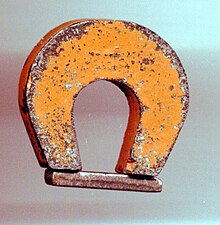Магнит
Магнит — хăйĕн магнитла уйĕ пур ĕскер.

Ахăртнех, авалхи грексем каланинчен тухнă. Μαγνῆτις λίθος (Magnētis líthos), «Магнесия чулĕ» — Магнесия регион тата Пĕчĕк Азири авалхи Магнесия хули[1], авал унта чăнах та магнетит тăправĕсене тупнă[2]
Вуламалли тӳрлет
- "The Early History of the Permanent Magnet". Edward Neville Da Costa Andrade, Endeavour, Volume 17, Number 65, January 1958. Contains an excellent description of early methods of producing permanent magnets.
- "positive pole n". The Concise Oxford English Dictionary. Catherine Soanes and Angus Stevenson. Oxford University Press, 2004. Oxford Reference Online. Oxford University Press.
- Wayne M. Saslow, Electricity, Magnetism, and Light, Academic (2002). Chapter 9 discusses magnets and their magnetic fields using the concept of magnetic poles, but it also gives evidence that magnetic poles do not really exist in ordinary matter. Chapters 10 and 11, following what appears to be a 19th-century approach, use the pole concept to obtain the laws describing the magnetism of electric currents.
- Edward P. Furlani, Permanent Magnet and Electromechanical Devices:Materials, Analysis and Applications, Academic Press Series in Electromagnetism (2001).
Асăрхавсем тӳрлет
Каçăсем тӳрлет
| Магнит Викиампарта? |
- How magnets are made 2013 ҫулхи Пуш уйӑхӗн 16-мӗшӗнче архивланӑ. (video)
- Floating Ring Magnets, Bulletin of the IAPT, Volume 4, No. 6, 145 (June 2012). (Publication of the Indian Association of Physics Teachers).
- A brief history of electricity and magnetism